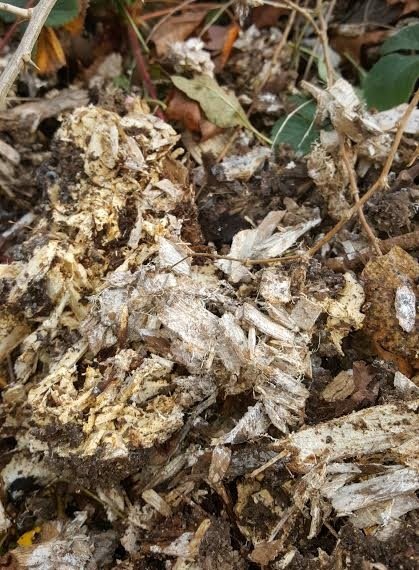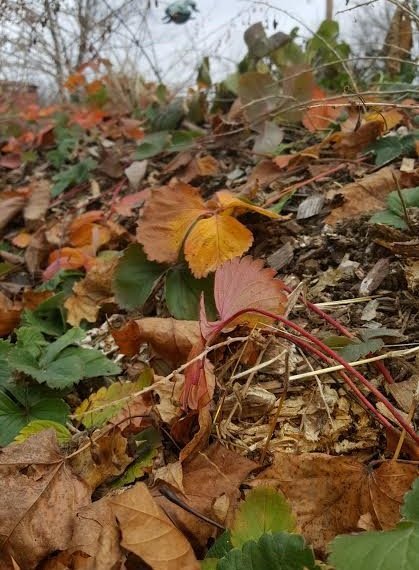
Hügelkultur
Hügelkultur is a German word that means mound culture or hill culture. This is a growing method that has been used for years, but was made popular by the greats like Geoff Lawton, Sepp Holzer, and (Wild man) Paul Wheaton.
Hügelkultur is a process that mimics what happens in a forest on an annual basis. Trees fall, leaves fall, seeds get covered, winter and rains germinate: from death, life begins.
It reminds me of a cartoon I saw once where a guy parked a truck under a tree when he was hurt and hospitalized for a year. During that year, leaves and seeds fell from the tree and, with the weather, composting started turning to soil. The seeds turned to plants and trees. When the guy was finally released from the hospital, he had a small forest growing in his pickup bed.
Don’t fight nature, work with it! The greats of Permaculture, whom I have mentioned above, realized there was something to this Hügelkultur and they began to experiment with it. From them and their research I started to make my own Hügel (short for Hügelkultur) beds. I had to make them smaller, because I have a small plot, but they have been none the less productive.
I’ll explain some of the reasons I chose to use Hügels here on our Homestead. These may be different reasons than you may have but everyone’s situation is a little different. I live in Northeastern Pennsylvania where we have cold weather. You may be in a hot climate where you may need to do things slightly different.
I had a lot of dead and dying wood. We bought a plot of land that was surrounded in wood that had been neglected. The brush took up 10’ of the perimeter of our homestead and for a small homestead that was valuable real-estate. I also had a few trees that needed trimming. They were casting too much shade, making some of our land unusable, and they were filling my gutters with leaves.
I had a cord or two of branches and logs that were perfect for building a Hügel. I was also lucky enough to get a few free loads of wood chips from our township. These were all the goods I needed to make our Hügels.
Health reasons may be another reason for building Hügels. I have a bad back from an injury and I want to make things easier for myself as I get older. I just don’t have a good time bending over for long periods in the garden and it makes it easier for me to harvest standing. The Hügel puts most of the fruit and vegetables where they can be picked easily. It also made it easier for me to get help. When it’s an easier job, it’s also easier to get extra help!
With our cold winter climate I always worry about losing plants to the cold. If my plants have to stay outside in the cold, I use a Hügel, because of the composting action underground. Having the composting action keeps roots alive while the top may die.

A great example is my figs. I love figs and they always produce late. The figs in my Hügel produce earlier and the roots survive the winter. The figs in my more traditional areas produce later and have to be dug out and brought inside during the winter.
My property is at a slope, so my Hügels act as swales catching run off. I have a farm above me and they don’t use any chemicals on my side of the hill. The other side, they let it fly! I get a lot of their run off from this hillside and it’s good fertile runoff. I had it tested when I moved here and it didn’t show up with anything I need to worry about. So, I try and catch and keep that wonderful free earth that just shows up. I make these Hügels in a way that catches some and then runs down to others. I think it looks similar to a waterfall on its side.

They also add beauty and interest to visitors, because most people have never heard of Hügelkultur. When I have a class or people come over they look at it and act as if they don’t see it. When I bring it up they tell me they were wondering what it was. During the fall, they do look strange, but the summer is a different story.
The summer brings a beautiful sight full of thriving plants. It’s almost comical watching the passersby rubbernecking to catch a glimpse of what I have going on. I take that as a major compliment and know that at times it brings me new friends.
When I dig a Hügel I take advantage of the clay, which I put aside for projects like cob ovens and rocket stoves. Usually I make a ditch 2’-3’ deep and then fill it with wood, branches and wood chips like I explained earlier. I will backfill it with the soil I removed and mix in some compost and whatever organic matter I have. I try not to leave air pockets or plant roots can rot.
Then, I cover the mound with more organic matter like leaves, straw and wood chips. That’s really the bulk of it and I think as time goes on the mound becomes more fertile. I’m wondering if after 5-8 years I may need to remake the Hügel after the buried wood has fully composted, but I will have to wait a few years and let you know.
I read that putting stumps standing up in the Hügel makes wicking of water more efficient. I have done it that way, but don’t really have a way to say if it is better. I do it anyway because it just seems more natural. I would imagine that water will be soaked up as if it were a straw.
Don’t be afraid to dig up the yard to make a Hügel. Grab a pick and shovel and give this growing method a shot, you won’t regret it. I just don’t see any drawbacks growing in this method. I’m sure you will be helping friends build theirs after they see how productive yours is.













I have noticed two issues with hugelkultur.
Water can tend to run off a mound so if you are in a low rainfall area where I do it is better to dig a deeper hole and have the resultant surface slightly below ground level so water runs into it rather than off it.
Secondly as the organic matter breaks down at uneven rates holes can open up and the ground can become unstable. I have had to prop up fruit trees that were falling over. I have another large kultur where walking on it needs to be done carefully to avoid breaking an ankle. Another one is really dangerous to put up a ladder on as a leg of the ladder can suddenly have the ground give way under it.
That said a neighbour who does it with hardwood logs that are carefully packed next to each other over a bulldozed flat surface hasn’t had these problems (yet) with the orchard he has planted in it.
Does anyone have any idea if I can build upon concrete path and soil? I have a few site choices for the Hügel but just wondering if I can slope build incorporating the down slope concrete as well as the higher slope?
Hello Bron, I’m not really sure of your explanation. If you mean can you build a Hugel on concrete the answer is you may. If you have a slope above it, you could possibly wash your hugel away. If you are on flat or a light slope you should be fine but it should be smaller. I don’t want to say for sure without having more detail.
I am in the process of starting a permaculture garden and have already set a couple of hugelculture. I have rat nesting there and a quick online research brought me to many other gardeners with the same problem. What can I do to avoid the rat problem? Thanks
Hello Ines, The easiest thing to do it put out a rat trap. Tie it to something with string so it wont go far. If the rats not causing damage you may want to leave it alone. I personally leave all pests alone until I see them causing real issues. Rats can cause disease though so it’s really up to you.